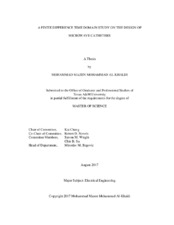| dc.contributor.advisor | Chang, Kai | |
| dc.contributor.advisor | Nevels, Robert D | |
| dc.creator | Al-Khaldi, Mohammad Mazen Mohammad | |
| dc.date.accessioned | 2018-02-05T16:48:10Z | |
| dc.date.available | 2018-02-05T16:48:10Z | |
| dc.date.created | 2017-08 | |
| dc.date.issued | 2017-05-17 | |
| dc.date.submitted | August 2017 | |
| dc.identifier.uri | https://hdl.handle.net/1969.1/165697 | |
| dc.description.abstract | .An investigation of the design aspects along with proposed improvements in the construction of microwave ablation catheters are reported in this thesis. The computational methods used to carry out this research include an in-house created cylindrical coordinate rotationally symmetric Finite Difference Time Domain (FDTD) scheme.
Firstly, a systematic means of modelling and designing microwave catheters is proposed. The method capitalizes on the rotationally symmetric nature of the microwave catheter and reduces the design from three dimensions to a two-dimensional problem.
Secondly issues related to resonant frequency and leaky waves, an inherent property of microwave ablation, are investigated and subsequent solutions are proposed. For the issue of resonant frequency, the addition of a terminating cap halves the catheter’s resonant frequency allowing for acceptable return loss, less than -10 dB, at a resonant frequency of 2.7 GHz without a sleeve choke and 2.45 GHz with a choke.
Several designs are investigated in order to eliminate the power coupled into waves travelling along the coaxial feedline’s exterior. The proposed catheter design with the sleeve choke is successful at eliminating surface waves whilst attaining a return loss of -14.61 dB at resonance. The internally matched catheter is equally as effective and attains a return loss of -49.39 dB at resonance while the catheter with a floating sleeve only partially reduces the amplitude of surface waves whilst achieving a return loss of -39.08 dB at resonance. The effectiveness of adding a dielectric cylinder around the monopole in order to improve return loss, bandwidth and overall Specific Absorption Rate (SAR) distribution is also investigated.
Near to far field transformations are implemented and the far field pattern of the catheter is shown to be that of a dipole, at resonance. Furthermore, a dispersive FDTD algorithm is developed to incorporate a metamaterial plug. The effects of this are shown to be highly dependent on the dielectric properties of the metamaterial and act to lower the resonant frequency allowing for overall length reductions. Finally, the bioheat equation is investigated and is implemented in the context of microwave catheters by analyzing temperature rise at varying radial distances from the catheter. | en |
| dc.format.mimetype | application/pdf | |
| dc.language.iso | en | |
| dc.subject | FDTD | en |
| dc.subject | Catheters | en |
| dc.subject | Microwave | en |
| dc.subject | Electromagnetics | en |
| dc.title | A Finite Difference Time Domain Study on the Design of Microwave Catheters | en |
| dc.type | Thesis | en |
| thesis.degree.department | Electrical and Computer Engineering | en |
| thesis.degree.discipline | Electrical Engineering | en |
| thesis.degree.grantor | Texas A & M University | en |
| thesis.degree.name | Master of Science | en |
| thesis.degree.level | Masters | en |
| dc.contributor.committeeMember | Wright, Steven M | |
| dc.contributor.committeeMember | Su, Chin B | |
| dc.type.material | text | en |
| dc.date.updated | 2018-02-05T16:48:11Z | |
| local.etdauthor.orcid | 0000-0002-7827-1148 | |


